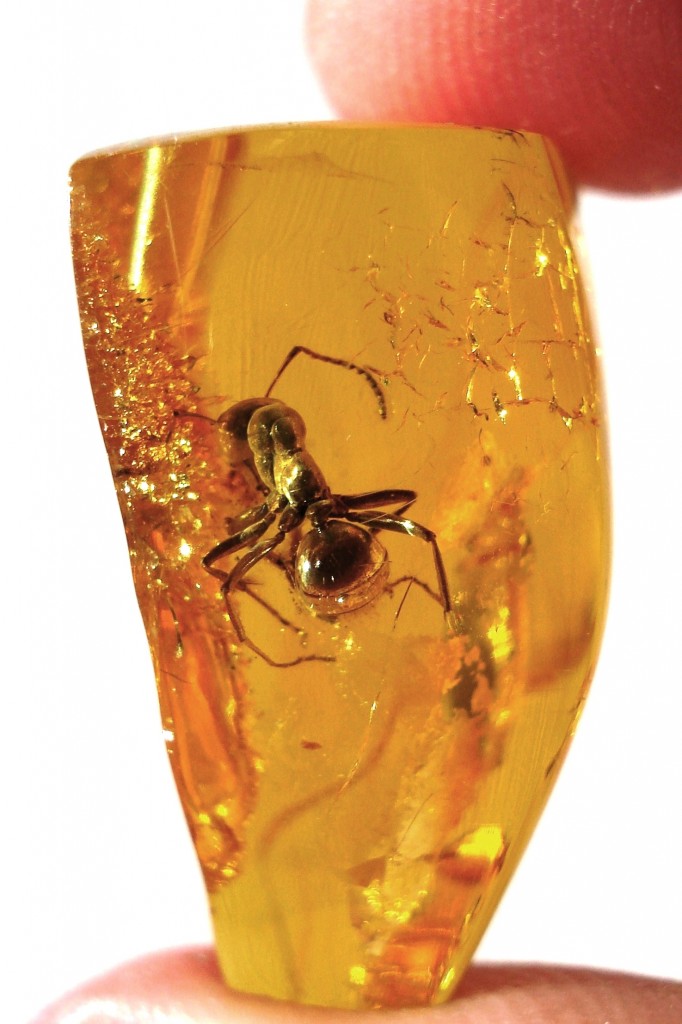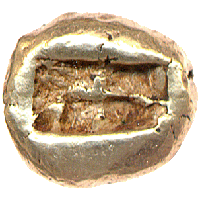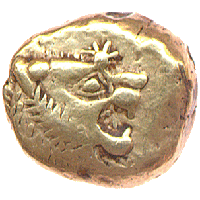
by Patrick Hunt
Historical linguistics often surprises us about how old are some of the words we use today, especially when we might expect they were coined only within the last century or so. While some of these old words, either commonplace like “star” and “myth”, or not so common like “emery”, have their derivations in the Bronze Age or Classical world millennia past, other words like “electron” – and the Latin version in electrum – also have old and venerable stories that have preserved many ancient details, like primeval insects caught in amber.
In Ancient Greek electron, sounding as Elektron (ἤλεκτρον) was a word used for amber, the precious fossil resin from ancient trees. Amber was valued in antiquity although its sources were either unknown according to Theophrastus (On Stones 29) or possibly found at the Celtic, Western margin of the world according to Herodotus (History 3.115). Amber was a rare and beautiful commodity, traded from the Baltic north to the Mediterranean south. It was as valuable as other ‘gems’ and highly prized in antiquity for its translucent, gold-like color and found in early Etruscan tombs of the late 8th century BC in quantity. Its metaphysical or poetic associations are fascinating. Similar to Greek ideas, amber was often thought in some folklore to be the distillation of sunlight and possibly a protective amulet against certain ailments or evils. Ancient Greeks also connected this word for amber to elector, sounding as Ä“lectÅr (ἠλÎκτωÏ), for the “beaming sun” and this derived word was also related to fire. Amber was poeticized in myth as the congealed tears of the mourning sisters of Phaethon, the sun’s ephemeral charioteer whose name conveyed “shining”. [1]
The Ancient Greek word electron was also used to describe first a natural then a man-made alloy of gold and silver, a precious amalgam and medium of exchange in rare metal bullion used to pioneer coinage in the Mediterranean world. Homer mentions the metal alloy “electrum” (electron) in Odyssey 4.73 when Telemachus refers to the splendor in the Palace of Menelaus, speaking about its echoing halls with the “flashing of electrum” in brilliant light effects. In antiquity the old system of barter and trade in goods like foodstuff or other bulk resources was replaced by being abstracted into these new symbols of value represented in metal tokens. While this gold and silver alloy occurred naturally along the Pactolus River in ancient Lydia, some of the earliest coins in the West were made of ‘electron’ (electrum) in small ingots from Lydia, minted by Kings Alyattes and Croesus circa 600-545 BC. [2] In Ancient Latin as in Greek, electrum was both an alloy of gold and silver . Virgil (Aeneid 8.402) has Vulcan speak of molten electrum and in Latin this word could mean amber as well as in Pliny (Natural History 37.2.11).


Finally, possibly because of amber’s highly conductive property, the Greek word electron was the modern (late 19th century) source word for “electron”, the charged particle in physics; also becoming the source word for “electric” and “electricity”. According to Europhysics News (1998), George Johnstone Stoney, an Irish physicist and Fellow of the Royal Society, deserves the credit in 1891 for first applying the ancient word electron “to a hypothetical small unit of electrical charge”. [3]
In retrospect, amber was even recognized in antiquity as a highly conductive material, quickly warming to the touch, and for this property was thought to be connected to dormant or even metaphysical life. New research on Baltic amber evidences that Neolithic cultures around the Baltic Sea gathered amber for jewelry as far back as 13,000 years ago. David Grimaldi has reported on this in an article,”Pushing Back Amber Production”, Science Magazine (October, 2009). In fact, when considering how fossil amber itself may be so old, sometimes from trees that lived hundreds of millions of years ago, this means that human association with amber is in reality a short time.
In the Iron Age Hallstatt period, 8th-6th c. BC, Baltic amber became especially abundant in trade with Italy in the Villanovan period (before established Etruscan dates) and the following Etruscan culture prized amber. By the sixth century BC rich Italian amber-carving workshops sprung up for this luxury good valued by elites. This trade covered many middlemen across Europe and the Alps, and Celtic chieftains valued amber as a commodity appreciated about as much as Greek wine, although it brought a greater price when traded to Italy.
A primary ancient Baltic amber source was the Bay of Gdansk (Danzig) and European map of Samland, East Prussia, in 1539 depicts amber collection from the ‘Ripa Succini’ (“Amber Coast”) with barrels. Succinum for “gumstone” was another ancient Latin name for amber. The Gdansk coast still prolific with 4,000 kg amber yields around 1998. Archaeologist and historian Kristiansen relates:
“In the 19th century yearly production was 500-600 tons, used in lacquerwork and for cigarholders. The traditional method, still employed today, is to collect the amber in nets as it washes in after storms with other light material. Especially large amounts of amber appear on exposed coastlines with heavy erosion during storms, such as the west coast of Jutland and the Pommeranian coast, where the amber-rich layers are washed out. After a single storm in 1862, 2000 kg of amber was collected from a 7-km stretch of coast at Palmnicken in the eastern Baltic.” [4]
Of course this brings to mind the infamous Amber Room of the Russian Catherine Palace of Tsarskoye Selo finished in 1709, lost or destroyed in World War II after Nazi theft but lavishly restored with new amber in 2003 with its polished, gleaming golden walls of amber, the proud hallmark of fabulous wealth on display from bygone years.
Thus, the continuity of expanding meanings for electron and electrum from the ancient world through the present is an exciting exploration in philology, ancient material culture and economic history. The finely-detailed insects embedded in fossil amber for millions of years, preserved for near eternity, remind us that electrum can last far longer than the ancient cultures who valued it as a precious substance. This long timeline ought to be humbling to mortal humans.
Notes
[1] H. G. Liddell & R. Scott. Greek-English Lexicon, 9th ed. Oxford University Press, 1996, 768.
[2] Richard Seaford. Money and the Early Greek Mind: Homer, Philosophy, Tragedy. Cambridge University Press, 2004, 114, 117.
[3] Patrick Wayman. “Stoney’s Electron” in History of Physics. Europhysics News 28 [5-6] (1998) 159-60.
[4] Kristian Kristiansen. Europe Before History. Cambridge University Press, 2000 ed. , esp. 233 & ff.